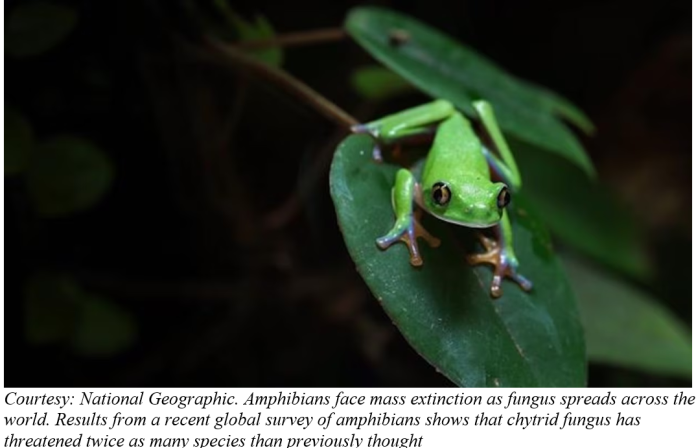Amphibians are small cold-blooded vertebrates (vertebrates have backbones) that do not have scales. They live part of their lives in water and part on land, thus, called “amphibians”. However, they need water, or a moist environment to survive. The species in this group include frogs, toads, salamanders, and newts. All can breathe and absorb water through their very thin skin.
There are 8743 species of amphibians in the world. The world’s smallest amphibian is a frog from New Guinea – “Brazilian Flea Toad” (Paedophryne amauensis) with a length of just 7 mm. The largest living amphibian – “Chinese giant salamander” (Andrias davidianus) – measures about 1.8 m.
In Bangladesh a total of 58 species of amphibians are found. Among them two are Caecilians, two toads and the rest are frogs. Most of the amphibians of Bangladesh – about 50 – are confined in the forest areas. Only 16 species of frogs are found in and around homesteads and agricultural fields. The mixed-evergreen forests of Chattogram and Chittagong Hill Tracts are home to 49 species of amphibians, while 47 species are found in the forests of northeast Bangladesh, 28 species in the Madhupur Shal forest, and the Sundarbans supports only 10 species of amphibians.
Most of the amphibians have a wide range of habitats; but some are habitat specific. Understandably, the habitat specific amphibians are more sensitive to environmental changes
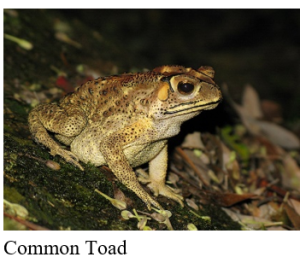 One of the most common amphibians of the country is ‘Common Toad’, locally known as ‘Kuno Bang’. It is found almost everywhere, including around homesteads, in agricultural fields and forests. Another well-known frog – a ‘Indian Bull Frog’ (Sona Bang) – is also the largest frog of the country. It is usually found on the banks of ponds and in paddy fields.
One of the most common amphibians of the country is ‘Common Toad’, locally known as ‘Kuno Bang’. It is found almost everywhere, including around homesteads, in agricultural fields and forests. Another well-known frog – a ‘Indian Bull Frog’ (Sona Bang) – is also the largest frog of the country. It is usually found on the banks of ponds and in paddy fields.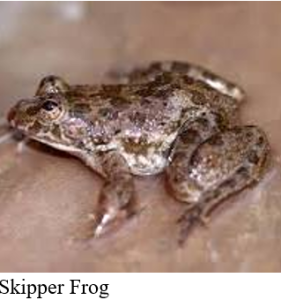
Skipper frogs’ (Kotkoti Bang) are found in road side ditches and in stagnant rainwater. It is one of the few diurnals (active at day time) amphibians in the country. Marshy grasslands are home to ‘Cricket Frogs’ (Jhi-Jhi Bang). ‘Green Frog’ (Sobuj Bang) is completely aquatic and camouflages in aquatic vegetations with its green colour. It is the only frog which eats aquatic vegetations along with aquatic insects.
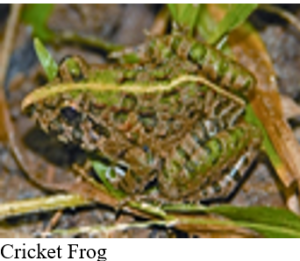
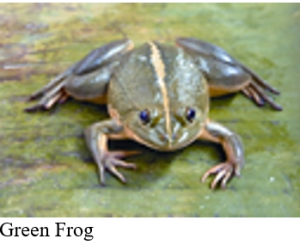
The diet of ‘Sona Bang’ is very diverse; they consume variety of insects, small fish, small frogs, small birds even small snakes
‘Tree Frogs’ (Gecho Bang) live in trees and bushes; consume insects from trees. If you walk through the rural area during the rainy season, you must hear the crock of Common Tree Frog (Gecho Bang) in the evening. Most of the tree frogs, including Twin-spotted Frog (Dui-dagi Gecho Bang), several species of Bush Frog (Khude Gecho Bang), are confined to the forests. They cannot survive outside the forest environment.
‘Smith’s Litter Frog’ (Holde-chokha Bang) belongs to fossorial species, and lives under the leaf litters and soft soil. They only come out for the breeding purposes during the rainy season. The male of this species has a very loud breeding call (advertisement call) which can be heard from more than a kilometre distance.
‘Berdmore’s Microhylid Frog’ (Boro Lau Bichi Bang) is the only winter breeder in Bangladesh. Their breeding call can be heard during cold winter months (December-January). During the breeding season, male frogs become more colorful to attract female frogs. Females choose their mates by considering the male’s bright colour, vocalization quality and ability to defend the territory.
None of the toxic frogs is found in Bangladesh except the ‘Green Cascade Frog’ (Sobuj Jhorna Bang). Its skin mucous secretion (odoriferous) is toxic and can cause allergic reactions to human body. This species is only found in the active waterfall areas in the Hill Tracts of Bangladesh.
 |
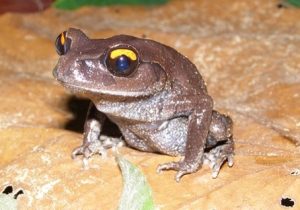 |
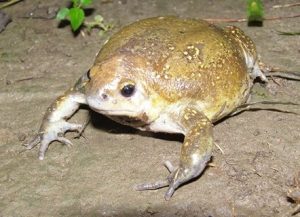 |
| Common Tree Frog | Smith’s Litter Frog | Balloon Frog |
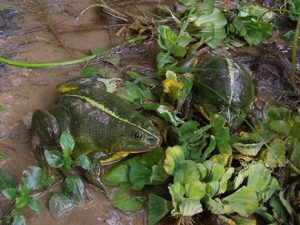 |
 |
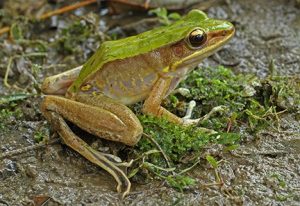 |
| Green Frog | Indian Bull Frog | Green Cascade Frog |
Frogs are the best biological pest controller as they can consume a huge number of insects every day. However, during the 1970s and the 1980s frogs were intensively harvested from the nature to export frog legs for foreign currencies. Within a few years of frog harvesting for exports, the insect pest population boomed. The cost of additional pesticides that the country had to import exceeded the amount that the country had earned from the frog leg exports. Therefore, the government banned frog harvests and export of frog legs.
Amphibians of Bangladesh are facing different sorts of threats for their existence. Habitat destruction due to excessive use of fertilizer and pesticides in agricultural fields, industrial pollution, as well as hunting and climate change are the major threats. Amphibians living in forests are more vulnerable due to rapid deforestation. Ten species of amphibians are categorized as nationally threatened. Research on amphibians in the country is still insufficient. We need immediate steps for the conservation of amphibians of Bangladesh.

Md. Kamrul Hasan
Md. Kamrul Hasan is Professor of Zoology at Jahangirnagar University. He received his B.Sc. (Honours), M.Sc. and M.Phil. in Zoology from Jahangirnagar University, with specialization in wildlife ecology, management and conservation biology. He obtained his PhD from the University of California, Davis, USA in 2014. Dr. Hasan has been working on different aspects of wildlife ecology, management and conservation biology since 2000. He has published over 90 research articles in peer-reviewed national and international journals and co-authored several books and book chapters on different aspects of wildlife and biodiversity conservation in Bangladesh. His research interest includes wildlife ecology, wildlife population genetics, wildlife conservation & management, primates, herpetofauna, bats and other small mammals and ethnic people’s perceptions on wildlife conservation in Bangladesh.

